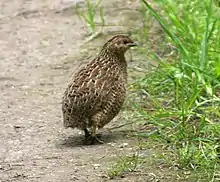| Old World quail | |
|---|---|
 | |
| Brown quail, Synoicus ypsilophorus | |
| Scientific classification | |
| Domain: | Eukaryota |
| Kingdom: | Animalia |
| Phylum: | Chordata |
| Class: | Aves |
| Order: | Galliformes |
| Family: | Phasianidae |
| Subfamily: | Phasianinae |
| Tribe: | Coturnicini |
| Groups included | |
| Cladistically included but traditionally excluded taxa | |

Old World quail is a collective name for several genera of mid-sized birds in the tribe Coturnicini of the pheasant family Phasianidae. Although all species commonly referred to as "Old World quail" are in the same tribe, they are paraphyletic with respect to the other members of the tribe, such as Alectoris, Tetraogallus, Ammoperdix, Margaroperdix, and Pternistis.[2]
New World quail are also found in the Galliformes, but are not in the same family (Odontophoridae). Buttonquails are not closely related at all, but are named for their similar appearance.[3] They are presently placed in the family Turnicidae of the Charadriiformes, classified as shorebirds.
The collective noun for a group of quail is flock, bevy or covey.[4]
Taxonomy
Old World quail may refer to the following species of Coturnicini:
- Genus Synoicus
- Brown quail, Synoicus ypsilophorus
- Snow Mountain quail, Synoicus monorthonyx
- Blue quail, Synoicus adansonii
- King quail, Synoicus chinensis
- Genus Coturnix
- Rain quail, Coturnix coromandelica
- Harlequin quail, Coturnix delegorguei
- Common quail, Coturnix coturnix
- †Canary Islands quail, Coturnix gomerae (fossil)
- Japanese quail, Coturnix japonica
- †New Zealand quail, Coturnix novaezelandiae (extinct)
- Stubble quail, Coturnix pectoralis
- Genus Perdicula
- Jungle bush quail, Perdicula asiatica
- Rock bush quail, Perdicula argoondah
- Painted bush quail, Perdicula erythrorhyncha
- Manipur bush quail, Perdicula manipurensis
- Genus Ophrysia
- Himalayan quail, Ophrysia superciliosa (critically endangered/extinct)
Behaviour
Old World quail are small, plump terrestrial birds. They are seed eaters, but will also take insects and similar small prey. They nest on the ground and are capable of short, rapid bursts of flight. Some species, such as the Japanese and common quail, are migratory and fly for long distances.[5] [6] Some quail are farmed in large numbers. The common and Japanese (or coturnix) quail are both raised for table meat or to produce eggs. They are also readily hunted, often artificially stocked on game farms or to supplement wild populations.
Migrating common quail are known to eat some poisonous seeds with no apparent ill effects but store the poison in their body fat, poisoning people who subsequently eat these birds; this condition is known as "coturnism".[7]
References
- ↑ Phillips, Lori Byrd (March 8, 2012). "Wikipedia Image of the Week #2". Wikipedia in Residence. Children's Museum of Indianapolis. Retrieved 31 March 2012.
- ↑ "Galliformes". bird-phylogeny (in German). Retrieved 2021-08-21.
- ↑ "Quail Information, including listing of species and photos". Beauty Of Birds.
- ↑ USGS – Animal Congregations, or What Do You Call a Group Archived 2015-03-20 at the Wayback Machine
- ↑ "Coturnix japonica (Japanese quail)". Animal Diversity Web. Retrieved 2007-09-21.
- ↑ "Coturnix coturnix (common quail)". Animal Diversity Web. Retrieved 2007-09-21.
- ↑ Coturnism: Human Poisoning By European Migratory Quail Journal of Cultural Geography Volume 7, Issue 2, 1987, Pages 51 – 65 Authors: David C. Lewisa; Elizabeth Metallinos-Katzarasb; Louis E. Grivettic doi:10.1080/08873638709478507
External links
 The dictionary definition of quail at Wiktionary
The dictionary definition of quail at Wiktionary